Bitcoin Breaks $93k, Signaling Market Strength.
24th April 2025 • 11 mins read
This Week’s Recap
- Cantor, SoftBank, and Tether back $3B Bitcoin investment vehicle: Cantor Fitzgerald CEO Howard Lutnick revealed a partnership with SoftBank and Tether to launch a $3 billion investment vehicle focused on Bitcoin. The fund will reportedly enable large institutions to gain Bitcoin exposure through a structured, regulated format. This move highlights growing confidence from traditional finance and tech conglomerates in Bitcoin as a long-term asset class.
- Trump memecoin events spark rally in $TRUMP token: The $TRUMP memecoin saw a sharp price increase after Donald Trump acknowledged the token and invited top holders to an exclusive gala dinner. This blend of political branding and Web3 engagement ignited speculative fervor, pushing the token’s market cap past $100 million. The event also sparked broader discussions about the role of memes and personalities in crypto markets.
- PayPal offers 3.7% yield on PYUSD stablecoin: PayPal has launched a 3.7% yield program for holders of its U.S. dollar-backed stablecoin, PYUSD, through a partnership with Paxos. This initiative aims to position PYUSD as a more attractive alternative to traditional savings and stablecoins like USDC or USDT, particularly for everyday users. The yield will be distributed to verified users who opt in, possibly setting a new precedent for fintech-led stablecoin incentives.
- Crypto-friendly Paul Atkins sworn in as SEC Chairman: Paul Atkins, known for his pro-crypto stance during past SEC tenures, has been confirmed as the 34th SEC Chairman. His appointment is expected to fast-track the review of pending crypto ETF applications and may mark a regulatory pivot toward clearer frameworks for digital assets. Industry observers anticipate his leadership could shape the next wave of institutional crypto adoption.
- Ripple stablecoin RLUSD launches on Aave V3 Ethereum: Ripple’s U.S. dollar-backed stablecoin, RLUSD, is now live on Aave V3 on Ethereum, allowing users to supply and borrow it within the protocol. This integration signifies Ripple’s growing focus on DeFi interoperability and expands RLUSD’s utility beyond payment use cases into decentralized lending markets.
- Institutional buying surges in Bitcoin and Solana: Institutions are doubling down on crypto as MicroStrategy and its affiliate Strategy acquired over 538,200 BTC in a strategic accumulation campaign. Simultaneously, GSR led a $100 million Solana-based investment in Upexi, a Web3 consumer platform, signaling growing institutional appetite for altcoins beyond Ethereum. The capital inflows highlight renewed conviction in long-term digital asset value.
- 13,000+ institutions now exposed to Saylor’s Bitcoin bet: More than 13,000 institutions hold exposure to MicroStrategy’s aggressive Bitcoin strategy, highlighting its growing impact across corporate portfolios. As exchange spot volumes fall, many traders are opting for longer-term exposure through institutional vehicles like MicroStrategy’s BTC-heavy treasury.
- Charles Schwab eyes spot Bitcoin trading by April 2026: Financial giant Charles Schwab is preparing to launch spot Bitcoin trading within the next 12 months. The move would mark one of the largest traditional brokerages entering direct crypto markets, potentially accelerating retail access to BTC through regulated channels.
- $TRUMP token jumps 8% despite $320M unlock: Trump’s memecoin rallied 8% amid low-volume holiday trading, defying sell pressure from a $320 million token unlock. The price move reflects strong community speculation and narrative momentum, even in the face of substantial dilution.
- Slovenia to impose 25% tax on crypto profits: Slovenia has announced plans to tax capital gains from cryptocurrency at a flat rate of 25%. The policy aims to bring clarity and increase tax compliance as crypto adoption grows across Europe, placing Slovenia among the more assertive EU countries in taxing digital assets.
- DOJ crypto memo and FTX/Celsius repayments may reshape market: A new memo from the U.S. Department of Justice outlines stricter enforcement guidelines for crypto crimes, coinciding with the start of repayments to FTX and Celsius creditors. These developments could set new legal precedents and significantly influence crypto valuations by restoring some user funds and clarifying enforcement priorities.
- Ethereum Layer 2s earned $768M in fees as scaling lags: Ethereum’s Layer 2 networks collectively generated $768 million in fees over the past year, but many continue to face congestion due to slower-than-expected upgrades in capacity. As demand for cheaper, faster transactions grows, the bottleneck in throughput could challenge user experience and developer adoption.
- Galaxy proposes new voting models to curb Solana inflation: After the community rejected SIMD-228, Galaxy Research has proposed alternative governance models to address Solana’s inflation rate. The new systems aim to better align validator incentives with long-term network sustainability while minimizing inflationary dilution.
- eXch exchange shuts down amid $1.4B Bybit hack fallout: Crypto exchange eXch has announced its closure following allegations of involvement in laundering funds from the recent $1.4 billion Bybit hack, which U.S. authorities have linked to North Korea’s Lazarus Group. The platform’s shutdown adds to regulatory scrutiny around exchange compliance and fund tracing.
- Canary Capital files for staked TRX ETF with SEC: Canary Capital has filed an application with the U.S. SEC for a staked TRX exchange-traded fund, aiming to bring yield-bearing exposure to Tron’s native token to traditional investors. The move follows increased ETF filings across major Layer 1 tokens amid growing institutional interest in staked assets.
- Arizona pushes forward Bitcoin reserve bill amid veto threat: Arizona lawmakers have advanced legislation that would allow the state to hold Bitcoin as a reserve asset. However, Governor Katie Hobbs has signaled potential opposition, warning she may veto the bill due to concerns over volatility and fiscal risk. The proposal reflects a growing trend among U.S. states exploring crypto-based treasury strategies.
- Kraken expands into forex with FX perpetuals and spot trading: Kraken has launched FX perpetual futures and added traditional forex trading pairs, broadening its derivatives product suite. The move targets institutional and global traders seeking to hedge or diversify through crypto-native platforms offering fiat currency exposure.
- Synthetix’s sUSD stablecoin loses peg again after updates: The sUSD stablecoin has fallen below $1 following recent protocol changes on Synthetix, raising concerns over the token’s peg stability. Developers are investigating liquidity and incentive misalignments that may have contributed to the sustained depeg.
Bitcoin Market Analysis
Bitcoin as of writing is at $93,210 after decisively breaking through key technical levels, marking one of its most significant structural shifts in months. The breakout began with a sharp move above the descending trendline that had capped price action since the $108K double top, followed by a reclaim of the 200-day simple moving average around $88.5K. This rally also completed the full retracement of the $74K–$90K gap left by the post-election surge in November 2024. That price gap had acted as a liquidity void, and its resolution now establishes $90K as a reliable support level. With momentum accelerating, Bitcoin now faces immediate resistance at $95K, a short-term ceiling tested intraday this week—with upside targets set at the psychological $100K level and the $108K cycle high. The technical structure now favors continuation, provided pullbacks are held above the $90K base.
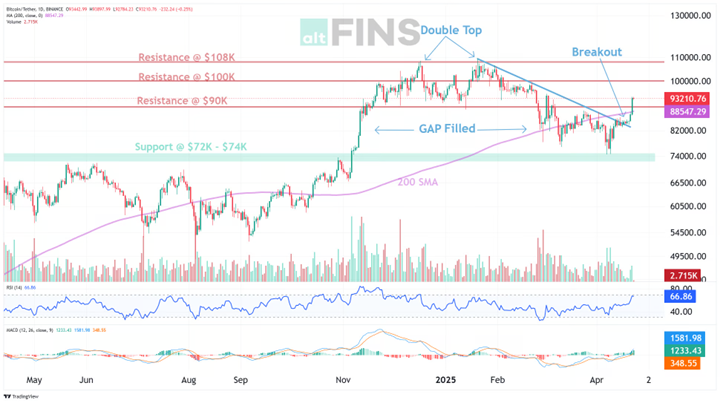
Source: https://altfins.com/technical-analysis
Momentum indicators further confirm the strength of this move. The Relative Strength Index (RSI-14) closed at 66.86, reflecting increasing bullish pressure while remaining below overbought territory, which leaves room for further upside. The MACD has also shifted decisively positive, showing a clean signal line crossover and the strongest positive histogram bars since February. Notably, this breakout was accompanied by a meaningful increase in volume, underscoring market conviction behind the move. From a trend perspective, Bitcoin has turned decisively bullish in the short term. The medium-term trend, while recovering, remains neutral as the asset works its way through previous highs. The long-term structure is still capped below the all-time highs but now appears increasingly constructive. Support remains solid at $75K and $60K, and current momentum suggests Bitcoin may continue climbing if macro conditions remain supportive.
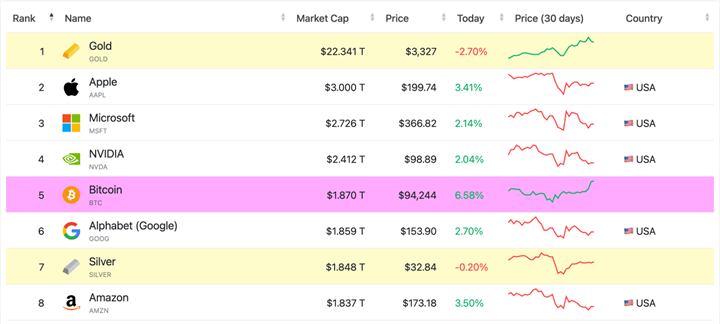
Source: https://companiesmarketcap.com/assets-by-market-cap/
Midweek, Bitcoin briefly surged to $94,000, pushing its market capitalization above $1.9 trillion and—albeit temporarily—surpassing both Amazon and Silver to become the sixth-largest asset globally. While the ranking was short-lived, with Bitcoin now positioned eighth behind Alphabet, Silver, and Amazon, the milestone was symbolically significant. For a short period, Bitcoin not only outpaced one of the largest technology companies in the world but also overtook silver, a long-standing store-of-value benchmark. This moment underscored the asset’s evolving narrative—from speculative trade to institutional-grade macro instrument. The backdrop was supportive: global risk sentiment was increasingly fragile due to mounting geopolitical tensions and a weakening U.S. dollar, catalyzing investor rotation into hard assets like gold and Bitcoin. The rally, while sharp, was not purely technical—it reflected the market’s re-evaluation of Bitcoin’s role in an uncertain financial environment.
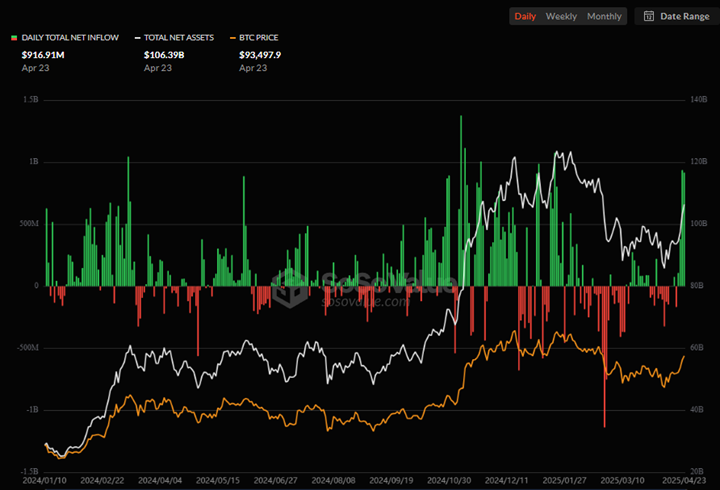
Source: https://sosovalue.com/dashboard/total-crypto-spot-etf-fund-flow
That shift in perception was echoed in capital flows. Bitcoin spot ETFs recorded more than $900 million in net inflows in a single day, the largest since their launch. BlackRock-led funds accounted for $108 million of that activity, while publicly listed companies now collectively hold over 688,000 BTC, highlighting the scale of long-term accumulation taking place outside of traditional crypto-native channels. Institutional capital has become a powerful force, increasingly driving price action and absorbing sell-side liquidity. These inflows are not reactive—they reflect a growing structural allocation from traditional investors seeking exposure to a sovereign-free monetary system with deflationary characteristics. Bitcoin’s relationship with mainstream finance is evolving: no longer merely an outsider asset, it is being positioned as a hedge and performance enhancer in multi-asset portfolios.
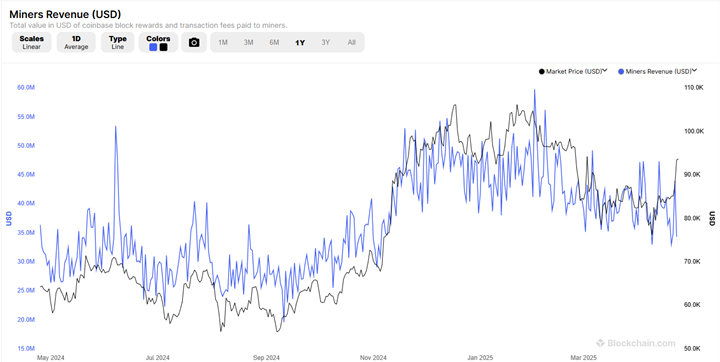
Source: https://www.blockchain.com/explorer/charts/miners-revenue
On the supply side, however, miner economics are deteriorating. Despite higher spot prices, post-halving block rewards have significantly compressed mining revenues, bringing them near record lows. This stress on the supply side contrasts with the strength on the demand side, and the divergence is worth noting. In previous cycles, miner selling often influenced short-term price dynamics. But in today’s market, the emergence of ETF demand has fundamentally shifted the balance. With ETFs absorbing a substantial portion of daily issuance and public companies continuing to accumulate, miner-driven selling is becoming less relevant to short-term volatility. The result is a market where supply pressure is structurally dampened, and the primary forces behind price discovery are institutional flows and macro positioning rather than miner liquidity needs.
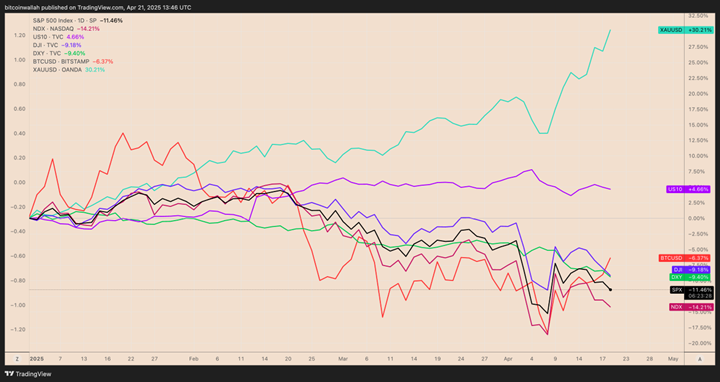
Source: https://www.fxempire.com/
Adding to this evolving structure, Bitcoin traded in close step with gold this week. As geopolitical concerns mounted and the U.S. dollar weakened, both assets moved higher—reinforcing Bitcoin’s correlation with traditional safe-haven assets. This behavior marks a departure from Bitcoin’s past as a high-beta risk asset and supports the narrative that it’s maturing into a digital macro hedge. Investors increasingly see Bitcoin not only as an uncorrelated asset but also as a strategic complement to gold, particularly in environments characterized by fiat debasement, geopolitical stress, and global capital flight. This dual behavior—trading like tech in bull markets and like gold in stressed regimes—may be a defining feature of Bitcoin’s next chapter.
Bitcoin enters the final stretch of April with renewed strength, both technically and structurally. The breakout above $90K, reclaim of the 200-day SMA, and retest of $95K resistance highlight growing confidence in the uptrend. Institutional flows are accelerating, miner influence is diminishing, and Bitcoin’s macro profile is rising. The temporary flip of Amazon and Silver, while brief, signals deeper shifts in perception—and perhaps foreshadows longer-term changes in capital allocation. With key support at $90K and the next critical resistance at $95K and $100K, Bitcoin now trades in a range defined by momentum, macro relevance, and a clear re-pricing of its role in the global financial system.
Ethereum Market Analysis
Ethereum (ETH) staged a notable rebound this week, breaking out of a prolonged falling wedge pattern and closing above the $1,700 resistance level for the first time in over a month. The breakout from this bullish reversal pattern marks a potential shift in short-term sentiment, with ETH reclaiming $1,769 after finding support near $1,500. This move is significant given that the overall trend remains strongly downward on both medium- and long-term timeframes. The breakout, however, positions ETH for a possible push toward the next resistance at $1,900. Traders eyeing this setup should remain cautious, as it represents a reversal trade against the broader trend. Risk management remains key, with stop levels around $1,580 to guard against a failed breakout. On the fundamental side, optimism around the potential approval of Ethereum spot ETFs with staking functionality in the U.S. later this year adds a speculative tailwind to the setup.

Source: https://altfins.com/technical-analysis
Momentum indicators support the emerging bullish sentiment but reflect a cautious tone. The RSI-14 currently sits at 54.06, indicating neither overbought nor oversold conditions, which is consistent with a market in early-stage recovery. The MACD has turned positive, with both the MACD line and histogram signaling early bullish crossover momentum, suggesting a potential continuation of upward price action. However, the 200-day SMA remains far above current levels (~$2,754), underscoring that the dominant trend still favors bears. Volume picked up during the breakout, validating the strength of the move. For now, the short-term trend is neutral, supported by a technical breakout, while the broader downtrend remains intact. ETH will need to decisively clear $1,900 and reclaim the 200-day SMA before the structure can shift from rebound to full reversal.
Beyond price action, Ethereum’s core development agenda is undergoing a meaningful shift. The Ethereum Foundation is intensifying its focus on improving Layer-1 scalability and user experience through a new wave of upgrades, including Pectra, Fusaka, and Glamsterdam. In a more transformative proposal, co-founder Vitalik Buterin has suggested replacing the Ethereum Virtual Machine (EVM) with a RISC-V-based architecture. This change could bring substantial efficiency gains—especially for zero-knowledge proof execution—while maintaining backward compatibility with current contracts. The move underscores Ethereum’s long-term ambition to position its base layer for mainstream adoption and protocol longevity, reinforcing the network’s leadership in innovation even as market cycles fluctuate.
Mark Your Calendars
- April 25, 2025 (Friday)
- USEC Crypto Task Force Roundtable on Crypto Custody
- This virtual roundtable, hosted by the U.S. Securities and Exchange Commission, will bring together regulators, institutional investors, and industry experts to discuss crypto custody solutions. Key topics include secure storage for digital assets, compliance with regulatory frameworks, and risk management for institutional portfolios. This event is critical for institutions navigating the evolving regulatory landscape.
- USEC Crypto Task Force Roundtable on Crypto Custody
Token Unlock
- April 27:
- Layer (LAYER) – $59.98M unlocking (12.87% of circulating supply)
- April 29:
- Sui (SUI) – $220.51M unlocking (2.28% of circulating supply)
- April 30:
- Aptos (APT) – $59.83M unlocking (1.83% of circulating supply)
- WhiteBIT Token (WBT) – $1.13B unlocking (27.41% of circulating supply)
